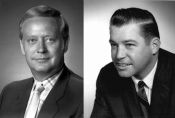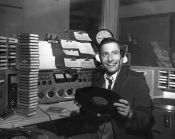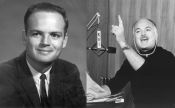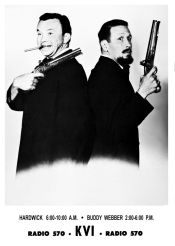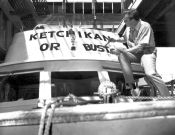|
www.theradiohistorian.org
Copyright
2023 - John F. Schneider
& Associates, LLC
[Return
to Home Page]
(Click
on photos to enlarge)
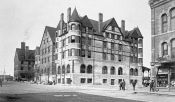
KVI's first home - the Hotel Tacoma
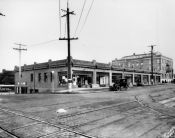
KVI's first transmitter was in this combination storefront and garage at 20 Tacoma Avenue. (Tacoma Public Library)
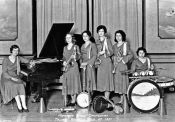
The Harmony Girls' Orchestra was heard on KVI in 1931.
Comic
Harry Stewart was heard on KVI from 1927-31. He developed the
character "Yogi Yorgesson", a mysterious Hindu mystic with a Swedish
accent. (Tacoma Public Library)
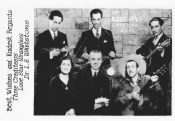
The Three Crediteers performed on both KVI and KMO.
Vernice Irwin became KVI's general manager on the death of her father, station owner Edward Dorenbecher.
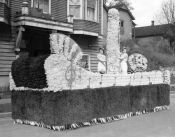
KVI entered this float in Tacoma's 1937 Daffodil Parade. (Tacoma Public Library)
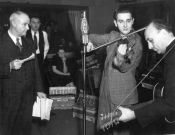
A rehearsal for a Tacoma Elks' program on KVI to benefit their
"Stocking Stuffers" benefit, November, 1927. (Tacoma Public Library)
Actor
Ronald Reagan visited the KVI studios on October 18, 1940, for
the opening of the film "Tugboat Annie Sails Again". Also seen
here are Alan Hale Sr., Hedda Hopper, Mayor Harry Cain, Marjorie
Rambeau and Donald Crisp. (Tacoma Public Library photo)
This
444-foot tower was built on "KVI Beach" on Vashon Island in 1937.
It still serves the station today. (SBE chapter 124 photo)
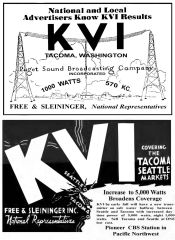
These KVI advertisements appeared in "Broadcasting" Magazine in 1936 and 1937.
|
|
A New Tacoma Signal
Is Born
Seattle’s radio
station KVI began life in Tacoma, Washington in 1926. A license was issued in November of that year
to the Puget Sound Radio Broadcasting Company.
The original owner was Harold W. Winningham, a radio amateur from
Wenatchee (7ZI) who was also involved in the marketing and sales of radio
receiving sets. His company also started
station KGEA in Seattle. (KGEA moved to
Longview in 1928 where it became KUJ, and then moved again to Walla Walla in
1931.) KVI was Tacoma’s third radio
station, preceded by KMO and KGB (deleted in 1925).
KVI’s first studios
were in the Hotel Tacoma, located at 9th and “A” Streets. The
transmitter and antenna were at 20 Tacoma Avenue, a two-story automobile garage
building. KVI operated with just 15
watts on 875.4 kHz (342 meters).
In 1927, Winningham transferred
the ownership of KVI to 44-year-old Edward Morris Doernbecher, the son of a
wealthy Portland manufacturing company owner. (His family was the founding contributor to
the Doernbecher Children’s Hospital in Portland.) In June of 1927, KVI increased its power to
50 watts and changed frequency to 1280 kHz.
In 1928, a new transmitter location was built near Des Moines in Kent,
Washington, and a new Western Electric 1,000-watt transmitter was
installed.
Limited Hours
Several frequency
changes were ordered in quick succession by the Federal Radio Commission, which
at the time was struggling with a congressional mandate to reduce interference
between radio broadcasters. In February,
1928, KVI moved to 1060 kHz with 250 watts, and then in September to 1340 kHz
with 1,000 watts, sharing time on the channel with KMO in Tacoma. In April,
1929, KVI moved to 760 kHz, a nationally-cleared channel assigned to NBC’s
flagship station WJZ in New York. That
meant that KVI’s permitted hours of operation ended at local sunset to protect
WJZ, although it could to return to the air at 10:00 PM, after sign-off in New
York, allowing KVI to operate again from 10:00 to midnight. Doernbecher would work for the next decade to
try and bring KVI back to full-time operation.
In 1929, the Radio
Commission proposed to shuffle the frequencies of three Seattle-area stations –
it wanted to move KJR from 970 to 760, KVI from 760 to 920, and KOMO to
970. This proposal alarmed the owners of
KJR, the area’s most powerful station, which operated full-time with 5,000
watts on a nationally-cleared channel.
It would have downgraded KJR to KVI’s limited-time frequency, while KVI
would have become a full-time clear-channel station. KJR appealed the decision to the courts, who
overturned the Radio Commission’s decision, and the frequency swaps never took
place. This was fortunate timing for
KJR, as it suddenly found itself in bankruptcy later that year, and might not
have had the resources to do battle with the Commission later on.
At this time, Edward Doernbecher
was the president and majority owner, Edward J. Jansen the station manager,
Willis Higley, chief announcer, and P.
G. Gale Chief Engineer. The other KVI stockholders
were all Tacoma-area businessmen.
Early Network
Programs
When the Don Lee
organization brought New York’s Columbia network to the West Coast in 1929, Doernbecher immediately joined the network, giving
KVI access to CBS’s programs. However, that
benefit was limited by KVI’s daytime hours – it was off the air in the evenings
when the most popular CBS programs were heard.
The solution for the Don Lee-Columbia network was to also sign up KOL in
Seattle -- KVI carried the daytime programs while KOL aired the network’s 5:00
to 9:00 PM schedule. (In 1930, the Don
Lee-Columbia network stations were:
KFRC, KHJ, KMJ, KFBK, KWG, KOIN, KVI, KOL, KFPY. KDB and KGB were added in 1931.)
In March of 1930,
there were brief reports in “Radio Doings” magazine that KVI had purchased KOL
in Seattle, subject to Radio Commission approval. This would have combined the area’s two CBS
affiliates into a single company. However,
the deal apparently fell through, as the stations continued on under separate
ownership and there were no further reports of a purchase or merger.
The Three Goals
Because of its limited
hours, KVI found itself at risk of losing its CBS affiliation to other area
stations. In order to protect his position,
Doernbecher and his daughter Vernice traveled by train to New York to meet with
the network’s president, William Paley.
He was told that KVI could become the exclusive affiliate for Seattle
and Tacoma if they would do three things – open a Seattle studio, get full-time
operation, and put a better signal into Seattle. Doernbecher resolved to do all three things.
The first and most
difficult of these tasks was to get a full-time frequency. So, when KVI’s license renewal application
was filed in 1931, he did not simply apply for renewal of his 760 kHz frequency
– instead he requested 570 kHz with unlimited hours – the channel occupied by
KXA in Seattle! That action set up a
hearing to be held before the Federal Radio Commission in Washington to decide
which station could use the 570 frequency – KVI or KXA. Doernbecher led a well-organized campaign to
win the contest. His argument was that
Seattle had plenty of radio stations, while Tacoma had only two – KVI and KMO -
with neither station having a full-time frequency. He organized a letter-writing campaign, and
20,000 Tacoma residents wrote to the Commission supporting KVI’s request.
The hearings were held
from December 8 to 18, 1931. Senator C.
C. Dill testified on behalf of KVI: “A
town of over 100,000 people is entitled to a radio station in this day and age
to get on the air with programs.” He
felt more people listen to radio between 6 and 8 PM than any other time, and that a local station
was needed during those hours.
Congressmen Ralph Horr of Seattle and Albert Johnson of Hoquiam also
testified in favor of KVI. For its part,
KXA, owned by radio engineer Vincent Kraft, apparently didn’t have the
political connections and didn’t mount a strong enough defense. The result was, the Radio Commission ruled
that KVI and KXA would exchange facilities – KVI would now operate on 570 kHz
with 1,000 watts day and 500 watts at night;
KXA would move to 760 kHz where it would operate with 1,000 watts until
local sunset. The stated reason for
decision was to create “a more equitable distribution of broadcast
facilities within the state of Washington.”
Now, with its CBS
affiliation and full-time frequency, KVI had become a more important regional
broadcaster, causing it to outgrow its modest studios in the Hotel Tacoma. Doernbecher told the press, “We want a
station second to none.” In
December, 1933, KVI moved into a 3,000 square foot suite on the fifth floor of
the Rust Building at 950 Pacific Avenue.
The rooms were finished in western knotty cedar with weathered oak and
hammered iron chandeliers. The main KVI studio was a room within a room,
finished in Weyerhaeuser Nu-Wood (a soft fiberboard material) with balsam
curtains for soundproofing. (This was a
fortunate move, as the Hotel Tacoma burned to the ground in 1935.)
KVI’s Big Signal
Now that KVI was on a
full-time frequency, Doernbecher’s second task was to put a stronger signal
over the city of Seattle. His new Chief
Engineer, Jim Wallace (who later owned KPQ Wenatchee) went looking for a new
transmitter site that would cover both Tacoma and Seattle. He ran a 75-watt portable transmitter between
midnight and 5:00 AM on 570 kHz, testing various locations. The site he chose was Point Heyer on Vashon
Island (today called “KVI Beach”). It was
a prominent point on the eastern shore of the island, equidistant from both
cities. The unobstructed salt-water path
across Puget Sound to both cities would be an excellent conductor of the KVI
radio signal.
On July 7, 1936, the
FCC approved KVI’s application to move its transmitter to Vashon Island and
increase power to 5,000 watts day, 1,000 watts night. The new facility included a 444-foot Truscon
self-supporting tower and a new transmitter (Western Electric model 355-D1), installed
in an existing beach-front home on the property. A license was issued for the facility on
December 15 and the new KVI was on the air, putting a strong signal into both
cities from 6:00 AM to midnight. In
1940, KVI was allowed to increase its evening power to 5,000 watts.
In 1937, fulfilling
the third part of Doernbecher’s commitment to William Paley, KVI opened
auxiliary studios in the Olympic Hotel in Seattle. The space was reportedly large enough to seat
an audience of 100 persons.
In March of 1938, CBS
announced it was transferring its Seattle station affiliation from KOL to KIRO. Being a Tacoma station, KVI was able to keep
its relationship with CBS for a while, but it eventually lost it in 1941 when
KIRO increased power to 50,000 watts from a new site just a half mile south of
KVI’s tower. CBS, realizing it now had
two affiliates with strong signals covering both Seattle and Tacoma, determined
that one of them was unnecessary. Despite
Paley’s commitment to the Doernbechers, KVI was the loser in that decision, and
it became an independent station for the next five years.
Vernice Doernbecher
During the years that
Edward Dorenbecher was pursuing his goal of turning KVI into an important radio
station, he had been suffering from ill health, making it increasingly
difficult for him to manage the station’s operations. In 1935, after undergoing a major surgery, he
asked his daughter Vernice to return to Tacoma to take on the job of Assistant
Manager and Comptroller of KVI. After
graduating from the University of Washington and Columbia University, Vernice Doernbecher
had built a business career with positions in Honolulu, New York City and San
Francisco, principally as an advertising executive. She was ready and qualified to step into KVI’s
operations.
On April 29, 1937,
Edward Doernbecher died of cancer at the age of 54. The controlling interest of KVI passed to his
wife Laura, and Vernice was named president and general manager. Edward’s other daughter, Dorothy, was named
secretary of the corporation. Now, Laura Doernbecher owned 1,041 shares of Puget
Sound Broadcasting Corporation, daughters Vernice and Dorothy each owned
110-1/2 shares, and other parties owned the remaining 98-1/2 shares (these were
subsequently acquired by Laura Doernbecher).
As all of this was
occurring, it appears that a romance was also blossoming in the
background. In 1938, Earl T. Irwin, a
sales executive with KVI’s advertising representatives Free & Peters in
Chicago, moved to Tacoma to become KVI’s new sales manager, also taking command
of KVI’s Seattle studio. Then, on
November 24, Irwin and Vernice were married in a private ceremony in Vancouver,
Washington.
No Sale
There were at least two
separate negotiations to sell KVI. In
1940, the owners of KIRO had several meetings with the Doernbechers to explore
the possibility, but this apparently never progressed beyond discussions. Then in 1943, Mrs. Doernbecher signed a memo
of intent to sell KVI to Sheldon Sackett and Ben Stone for $125,000, including
the land on Vashon Island. (Sackett and
Stone both owned other radio stations in the Northwest.) However, the negotiations eventually broke
down over the tax implications of the transaction. Mrs. Doernbecher withdrew her offer to sell
and stopped communicating with the buyers.
Sackett and Stone then sued Doernbecher for failure to fulfill a sales
contract, but the Superior Court of Pierce County dismisses the suit in 1944 on
the basis that a memorandum of intent to sell did not constitute a contract.
Your Seattle Mutual
Station
In August, 1946, after
operating for five years without a network, KVI acquired the Seattle-Tacoma
affiliation for the Mutual-Don Lee Broadcasting System, replacing both KMO in
Tacoma and KOL in Seattle. An article in
“Broadcasting” Magazine explained some details of the change: KMO owner Carl “Haymond stated that he
had been offered a new Don Lee contract with the provision that he either
purchase a Seattle station or move the KMO transmitter to cover both cities. In
making his decision, Mr. Haymond further explained, ‘We would have had to
identify ourselves exclusively with Seattle, since from a business point of
view, it is impossible for a Tacoma station to sell both markets in as much as
Seattle overshadows Tacoma.’ Mrs.
Vernice Irwin, president and general manager (of KVI), admitted she would ‘probably
move some of the station operations” to Seattle.’”
That statement by Mrs.
Irwin was a harbinger of things to come.
In 1947, she applied to move KVI’s city of license and main studio to
Seattle, and it was approved by the FCC effective March 30, 1949. According to former Tacoma broadcaster Tom
Read, “the reason they were able to move to
Seattle was that with 5 kW they could put a 25 mv/m signal over downtown
Seattle and Tacoma, which was an FCC requirement at the time.” In
March of 1939, Vernice
Irwin opened KVI’s new studios in the Camlin Hotel in downtown
Seattle. A small Tacoma studio was maintained for a short while
in the Winthrop Hotel, but it was soon quietly shuttered.
The move of KVI from Tacoma to Seattle was
ironic, as the only reason it had been allowed to take over KXA’s full-time 570
kHz frequency in 1931 was because it was a Tacoma station. After the move, Tacoma had just two local
stations – pioneer station KMO and newcomer KTBI (1942).
In addition to its
Mutual network programs, listeners made their way to KVI to enjoy the morning “Sunrise
Club” program, which dated back to the beginning years of the station. Deejay Harry Long was the popular host of the
show in the 1940’s and 50’s. During the
rest of the day, “Country and Western” music was king on KVI, with the “Sagebrush
Serenade” in the afternoon, “Chuckwagon Jamboree” at 5:30, PM and “Ranch House
Roundup” at 10:30 PM. Buck Ritchey was KVI’s
most popular country music personality, leading the station’s band, the K-Six
Ramblers (the name was derived from “K-VI”).
For two decades, Richey and Long carried on their artificial on-air “radio
feud” to the delight of local audiences.
The Golden West Era
In 1959, after 28
years of ownership by the Doernbecher family, Laura Doernbecher and Vernice
Irwin announced the sale of KVI to Golden West Broadcasters, owned by western
music star Gene Autry. The license
transfer was approved on August 25. Golden West also owned KMPC in Los Angeles and
KSFO in San Francisco, and programmed both stations with a highly-popular personality
disc jockey format. (Golden West would
add KEX in Portland to its stable of stations in 1962.) Autry immediately
jettisoned KVI’s affiliation with the Mutual Network and substituted a replica
of its California stations’ formats, introducing a new team of disc jockeys. Fred Van Hofen was the new VP/General Manager,
to be followed in later years by Bert West and Jack Bankson. KVI immediately moved into new $100,000 state-of-the-art
studios in the Tower Building, at 7th and Olive Way, and a new 5,000-watt
transmitter (Bauer FB-5000J) was installed on Vashon Island.
KVI publicized its new
format as the “Most Happy Sound”, promoted by jingles produced by Harry
Zimmerman, music director of the Dinah Shore TV Show. The new disc jockey lineup was:
6-9 AM Jerry Dexter
9-12 AM Bob Salter
12-3 PM Dale Starkey
3-7 PM Bob Hardwick
7-12 PM Bob MacDonald
12-6 AM Rod Hammett
Buck Ritchey was named
KVI’s operations manager, but the new format clearly didn’t suit his musical
tastes. Soon after, he joined the staff
of Country KAYO, where he was a key personality for many more years.
From 1969 through the
early 80’s, KVI was Seattle’s dominant station, featuring a mix of personality
disc jockeys, music, news, and sports. The
music was strictly “Middle of the Road” – artists like Frank Sinatra, Eydie Gormé,
Woody Herman, and Count Basie. Through
its peak years, popular KVI disc jockeys included Jack Morton (hired from KMO),
Jim French (from KIRO), Dave Clark (from KJR), Peter Boam (aka Peter B.), Al Cummings (from KOL), Buddy Webber, Ray Court
Robert O. Smith, Michael O’Shea, Bill Taylor, Jack Spencer, and a number of
others. The morning commute was aided by
KVI Skywatch reporter Cliff Murphy.
Authoritative news
reporting was also a key element of KVI’s success. Rod Belcher Bill Goff, and Lou Gillette were
early KVI reporters. At first, veteran
Seattle newsman Dick Keplinger announced the station’s three main newscasts – 8
AM, noon, and 6 PM. His noon report
originated from a special booth on the 8th floor of the Bon Marché
department store in downtown Seattle. In
1965, Bob Roberts joined KVI and delivered the noon newscast each day from
Seattle Times city room until 1973.
Play-by-play sports
was an important part of the KVI program schedule, with the station carrying
the baseball games of the Seattle Rainiers, Seattle Pilots (in their single
1969 season), and Seattle Mariners (1977-84), as well as the Seattle Sounders, University
of Washington basketball, and the WSU Cougars.
Radio drama was also a
special feature on KVI. In 1972,
afternoon host Jim French began producing a weekly half-hour radio detective
series entitled “Dameron”, heard Tuesday nights at 10:30. The cast include KVI
staffers Robert Hardwick and Lou Gillette, plus professional actors from the
community. The Jim French radio plays
eventually grew to encompass hundreds of programs - first heard on KVI, later
on KIRO, and finally in national syndication through Jim French Productions.
Undoubtedly KVI’s
biggest programming draw during the Golden West years was its morning drive
time host, Robert E. Lee Hardwick. He was
a morning fixture on KVI from 1959 to 1980 (except for a four-month break in
1963 when Golden West tried him out at KMPC in Los Angeles). His show was consistently number one in audience
ratings, and in 1975, he was Seattle’s highest-paid radio personality, at
$40,000 per year. In 1979, he was
reportedly voted Billboard Magazine’s Radio Personality of the Year. Hardwick’s morning show was light on music
and heavy on jokes and skits. He was particularly
known for his stunts: piloting a tugboat
to British Columbia to bring back a killer whale for the Seattle Aquarium; jet-skiing
740 miles from Ketchikan to Seattle; swimming the Bremerton-Seattle ferry route;
or climbing Mt. Kilimanjaro.
In 1976, KVI acquired
FM station KETO 101.5 which became KVI-FM – later changed to KPLZ. That station found success as an adult Top 40
station.
Oldies and “Hot
Talk”
In 1981, Shannon
Sweatte became KVI’s new general manager.
It was a time when younger radio listeners were migrating to the FM band. KVI’s ratings were falling, and it needed to
adapt to survive. In 1984, KVI changed to
an “oldies” format, featuring 1960’s and 70’s rock music, aiming for an older
demographic audience. Then in 1990, music
was completely abandoned as KVI became a talk station, featuring Rush Limbaugh
and other syndicated and local commentators. The change incensed KVI’s morning star Robert
Hardwick, causing him to quit his job during the middle of an 8:00 AM newscast.
(After a series of short-lived jobs at
mid-level area stations, Hardwick died of a self-inflicted gunshot wound in
1992.)
Seattle has always been politically liberal. At first, KVI used the
slogan "the balanced alternative", alternating liberal and
conservative talk hosts, but by 1993, KVI had dropped all its liberal hosts. One notable KVI commentator was local firebrand
Mike Siegel, who regularly attacked public officials on the air until he was eventually
fired in 1996 for attacking the mayor. In the evenings, the syndicated host Art Bell mused
about UFO’s and the paranormal.
In 1994, Gene Autry’s
estate was liquidated and KVI (with its sister FM station KPLZ) was purchased
for $11 million by Fisher Broadcasting, owners of KOMO-AM and TV. In 2002, KVI moved from the Tower Building to
KOMO’s new Fisher Plaza complex overlooking the Space Needle. In 2010, KVI switched back from conservative
talk to oldies rock music, but the format was a failure in the marketplace and
conservative talk soon returned. It
remains KVI’s programming format today.
In 2013, Fisher
Broadcasting sold all of its TV and radio stations to the Sinclair Broadcast
Group for $373 million. In 2021, Sinclair’s
Seattle radio properties – KVI, KOMO, and KPLZ – were sold to Lotus
Communications for $18 million.
REFERENCES:
- “Broadcasting”
Magazine – 12/15/1931, 4/15/1932, 5/1/1936, 7/1/1936, 10/1/1936,
6/15/1937, 10/1/1938, 12/1/1938, 6/24/1946, 4/4/1949, 10/30/1972,
- “Radio Doings” Magazine, 12/29/1929, 3/22/1930, 3/29/1930, 4/26/1930, 6/28/1930.
- “The Talking Machine and Radio Weekly” magazine, January, 1930.
- Wikipedia.org – KVI history
- FCC History Cards for KVI
- “Radio Service Bulletin”, Federal Radio Commission, 11/1926, 4/1927
- “KVI Opens Studios in New Quarters”, newspaper clipping, 1959
- Hidden History of Tacoma by Karla Stover, 2012
- “KVI vs. KXA – The Hearings” – by Tom Read, Northwest Pioneer Broadcasters
- “KVI, Inc., vs. Doernbecher” lawsuit, Supreme Court of Washington, 12/18/1944
- KVI-AM History – prepared for Soundies award, 2002
- "Radio Personality Commits Suicide”, Seattle Times, 6/4/1992
- “KVI Radio Fires Talk Host Mike Siegel”, Seattle Times, May 30, 1996
|
